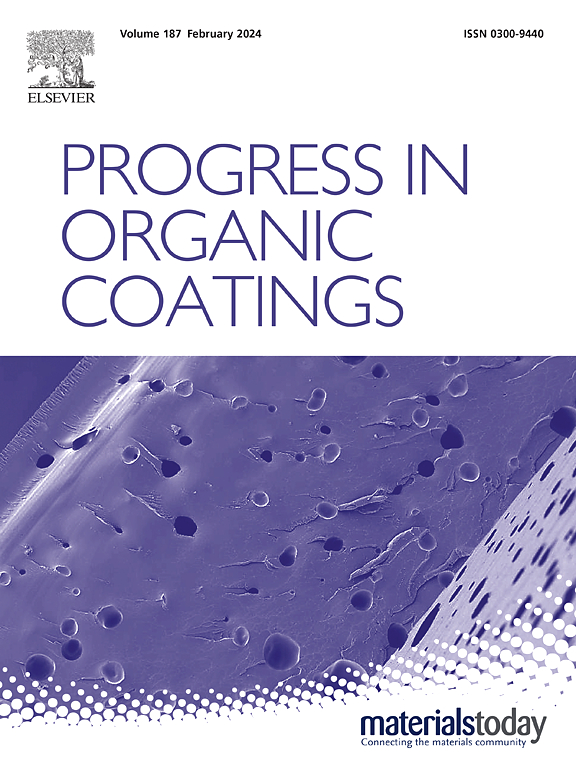Modeling and optimizing visible–infrared stealth performance of ultrathin metal nanoparticles/acrylic resin composite coatings
IF 7.3
2区 材料科学
Q1 CHEMISTRY, APPLIED
引用次数: 0
Abstract
Space stealth strategy is a key means to enhance the survivability of satellites, and its core lies in the realization of multispectral compatible stealth to cope with the complex space reconnaissance environment. In this study, an ultrathin composite coating is proposed, combining metal nanoparticles (NPs) with an infrared-transparent acrylic resin (AR) matrix to achieve visible–infrared compatible stealth performance. It conducts a systematic simulation study on the visible-infrared compatible stealth performance of composite coatings. Based on the Mie scattering theory and Monte Carlo ray tracing method (MCRT), we systematically analyzed the multispectral stealth performance of 11 spherical metal NPs composite coatings (Ti, Cr, Mn, Fe, Cu, Zr, Mo, Ag, Ta, W, Au) with different NPs size (20–100 nm), volume fractions (0.5 %–5 %), and coating thicknesses (0.5–5 μm). The coating's absorption rate in the visible spectrum (380–780 nm) and emissivity in the mid-far infrared window (8–14 μm) were numerically obtained. The results show that when the Ti NPs size is optimized to 50 nm, the volume fraction is optimized to 2 %, and the coating thickness is 1.5 μm, the composite coatings can achieve high visible light absorption of 91.4 % and low infrared emissivity of 0.19. This study not only provides a data-driven strategy for designing visible–infrared compatible stealth coatings but also offers a scalable approach for multispectral optical modulation, with promising applications in stealth technology, thermal management, and solar photothermal conversion.
超薄金属纳米颗粒/丙烯酸树脂复合涂层的可见红外隐身性能建模与优化
空间隐身战略是提高卫星生存能力的关键手段,其核心在于实现多光谱兼容隐身,以应对复杂的空间侦察环境。本研究提出了一种超薄复合涂层,将金属纳米颗粒(NPs)与红外透明丙烯酸树脂(AR)基体结合,实现可见-红外兼容隐身性能。对复合涂层的可见-红外兼容隐身性能进行了系统的仿真研究。基于Mie散射理论和蒙特卡罗射线追踪法(MCRT),系统分析了11种球形金属NPs复合涂层(Ti、Cr、Mn、Fe、Cu、Zr、Mo、Ag、Ta、W、Au)在不同NPs尺寸(20 ~ 100 nm)、体积分数(0.5% ~ 5%)和涂层厚度(0.5 ~ 5 μm)下的多光谱隐身性能。数值计算了涂层在可见光波段(380 ~ 780 nm)的吸收率和中远红外波段(8 ~ 14 μm)的发射率。结果表明,当Ti NPs尺寸优化为50 nm,体积分数优化为2%,涂层厚度为1.5 μm时,复合涂层的可见光吸收率为91.4%,红外发射率为0.19。该研究不仅为设计可见-红外兼容隐身涂层提供了数据驱动策略,而且为多光谱光调制提供了可扩展的方法,在隐身技术、热管理和太阳能光热转换方面具有广阔的应用前景。
本文章由计算机程序翻译,如有差异,请以英文原文为准。
求助全文
约1分钟内获得全文
求助全文
来源期刊

Progress in Organic Coatings
工程技术-材料科学:膜
CiteScore
11.40
自引率
15.20%
发文量
577
审稿时长
48 days
期刊介绍:
The aim of this international journal is to analyse and publicise the progress and current state of knowledge in the field of organic coatings and related materials. The Editors and the Editorial Board members will solicit both review and research papers from academic and industrial scientists who are actively engaged in research and development or, in the case of review papers, have extensive experience in the subject to be reviewed. Unsolicited manuscripts will be accepted if they meet the journal''s requirements. The journal publishes papers dealing with such subjects as:
• Chemical, physical and technological properties of organic coatings and related materials
• Problems and methods of preparation, manufacture and application of these materials
• Performance, testing and analysis.
 求助内容:
求助内容: 应助结果提醒方式:
应助结果提醒方式:


